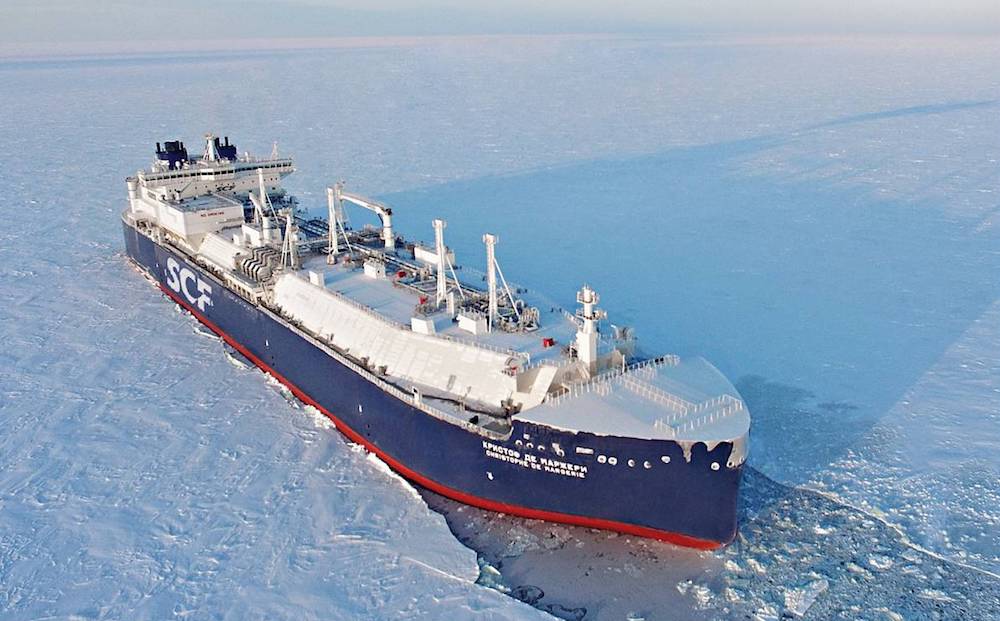With new technology, it’s full-speed astern for polar shippers
Look at them one way, and the generation of ships serving the Yamal LNG plant are tankers that can break ice. Look that them another, and they are ice-breakers that transport hydrocarbons.

When trying to get something to or from ice-filled waters, shippers have traditionally had several options at their disposal, all of which require some form of trade-off.
Icebreakers are perhaps the most obvious way of clearing a path, but, in addition to the extra cost, there is often waiting time if the owner wants to maximize its effort by organizing a convoy.
Cargo ships and tankers can themselves be hardened to withstand ice, and be built with a bow that is flatter than is found on standard ships, thus giving them some icebreaking capacity. This, though, makes a ship as much as 40 percent less efficient when sailing in open water, while also giving a ship an ability that will only be required for only a fraction of the overall distance. In the case of Russia’s offshore oil production in the Pechora Sea, for example, estimates are that only 10 percent of the distance between drilling sites and European ports are covered by ice.
A third choice is to transship cargoes from an open-water vessel to one built primarily for sailing in ice. But, this too adds time and cost to shipments.
[Wave technology is one-two punch for ice-breaking]
Ships cannot have two hulls, but they can sail in two directions. This is a fact that shipbuilders are taking advantage of as they are increasingly called on to design vessels that can serve a growing number of resource-extraction projects in the North.
The idea of building a ship that has ice-breaking and open-water sailing capabilities in equal measures, depending on the direction it is sailing is inspired by early polar mariners who found that doing so was more effective in some cases. In its modern form, it has been around since 1995, when the Röthelstein, an Austrian river ice-breaker that is also used to push barges, entered service.
Such ships are made possible by the development of pod-mounted propellers, which, unlike the traditional axle-mounted type, can be steered, affording greater maneuverability. In the case of icebreaking, it allows thrust and water flow to be optimized, giving more power in the direction it is needed and reducing resistance.
The idea has stuck, and a number of civilian and military vessels serving the North have since been developed. The newest of these, currently steaming towards the Yamal LNG plant, on Russia’s northern coast, is the Boris Sokolov.
Launched last week, the Boris Sokolov will primarily ship condensate — a form of hydrocarbon that is liquid like oil, but volatile like natural gas — to customers in Asia, during summer months, and Europe, during the winter, when the Northern Sea Route is closed to east-bound traffic.
A similar construction was used for the Christophe de Margerie, which entered into service in 2016, and the five other ice-classed tankers already serving Yamal. Eventually, a total of 15, all based on a design by Aker Arctic, a Finnish firm whose predecessor came up with the design for the Röthelstein and which patented a technology for steerable propellers and has since trademarked the term ‘double-acting ship’.
Though it is just the latest dual-purpose ship to enter service, the Boris Sokolov is the first designed to ship primarily condensate, though it can also be used to ship gas and oil.
When sailing ahead, the Boris Sokolov is designed to sail at 13 knots. Once it reaches ice, it can turn around and sail at speeds of up to 2 knots in ice that is 1.8 meters (6 feet) thick.
For that, it earns Russian authorities’ Arc 7 rating — the highest possible for a ship not built as an icebreaker — and in the process shows that, when it comes to polar navigation, two knots back is sometimes full-speed ahead.